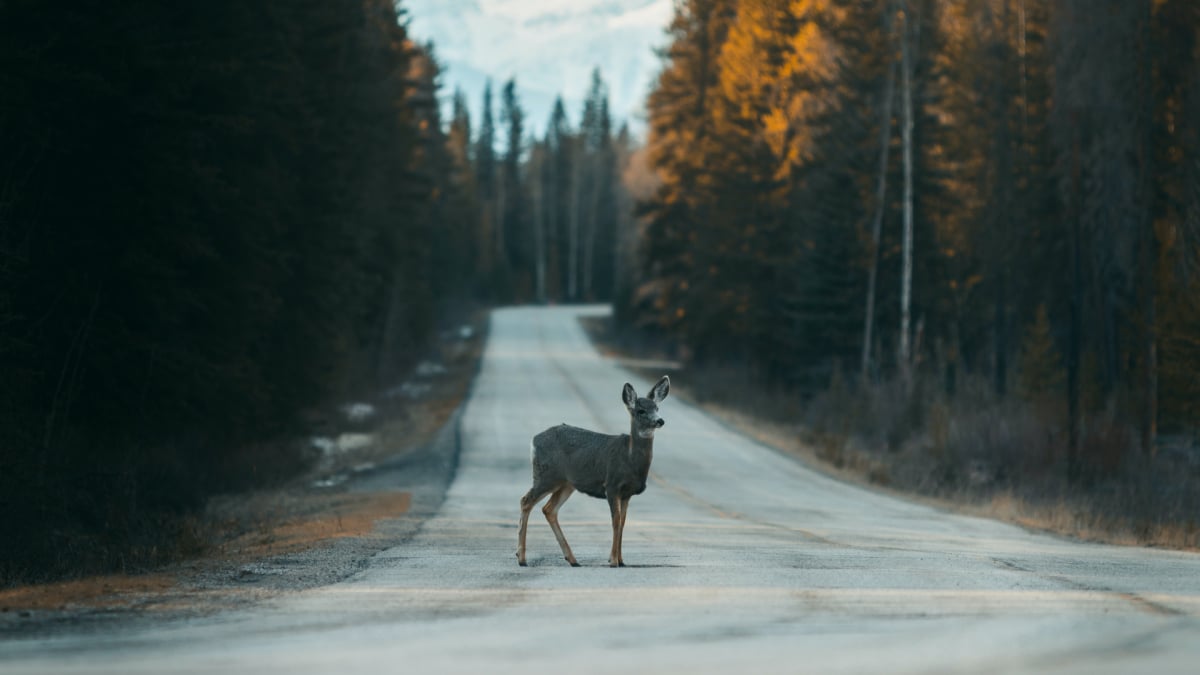
While deer can be seen in backyards and on roadsides year-round, they tend to be especially active in the fall, during the lead-up to their autumn breeding season—also referred to as the “rut,” according to the Pennsylvania Game Commission. When deer are focused on finding, and potentially chasing down, their future mate, they’re not exactly looking both ways before crossing a street. Plus, having fewer hours of daylight means we’re spending more time driving in the dark, when it can be especially difficult to spot deer about to make their way across the road.
As vigilant as you may be, sometimes the situation is out of your control, and you end up hitting a deer while driving. Here’s what to do if that happens, and some tips to help you avoid this type of collision.
Move somewhere safe
The first step is to try to move your vehicle to a safe portion of the roadway, says Paul Grattan Jr., a retired sergeant and 22-year veteran with the New York City Police Department, where he oversaw media and executive communications for the NYPD’s Transit Bureau. Turn your hazard lights on, and attempt to pull to the side of the road or a nearby area that is more removed from traffic.
If your car isn’t moving well, or doesn’t steer as you would expect, Grattan says to stop where you are. After a collision, you may hear noises from bumpers, fenders and other parts of the car rubbing against the tires or ground. “Generally, it’s safer to try to move the car a short distance to safety under these circumstances than to worry about some further minor damage to the vehicle,” he says.
Stay in your vehicle and call for help
Remain in your vehicle with your hazard lights on and call 911 to report the accident and any injuries, says Patti Yencho of Professional Insurance Advisors, who has more than 26 years of experience in the insurance industry. Make sure you and your passengers stay safe until the authorities arrive.
Take notes
Take note of the time and location of the accident, as well as any other information that will be useful for the police report and/or filing an insurance claim, says Alex Adekola, the CEO and Founder of ReadyAdjuster. Not sure whether your car insurance will cover the accident? “Hitting a deer falls under comprehensive coverage—not collision—so make sure you’ve reviewed your policy to see if you’re covered.”
Take photos
Once you’re in a safe location, take photos of any damage to your vehicle from several angles, and make a note of what the damage is in as great of detail as possible, says Eamonn Turley, an auto and insurance expert and the CEO of Multi Quote Time. “This documentation could be crucial when you file a claim with your insurance company to ensure that you get the compensation you deserve for repairs.”
Make sure your car is safe to drive
You’ve already moved your vehicle to a safe portion of the roadway, but how do you know if it’s safe to drive to your destination, or should be towed? According to Grattan, there are several indications that the car is better off being towed than driven. Some examples include:
-
There are fluids leaking. More than a few drops of fluid is a concern.
-
The airbags have deployed.
-
There is a visibility issue—the hood is blocking a clear view or the windshield is badly cracked.
-
The car is smoking or steaming significantly.
-
The brake pedal doesn’t feel the same—it goes to the floor, feels “mushy” or less firm.
-
Lighting is compromised.
-
Parts of the exterior are making contact with the tires or the ground.
Also, make sure nothing is dragging underneath your car, says Ethan Pickner, founder of AZ Health Insurance Brokers.
What to do about the deer
First and foremost, keep a safe distance from the deer. “From the injured animal panicking or becoming defensive, a nearby doe trying to protect her young, or the additional traffic safety concerns created by the situation, the safest option is to let the deer be,” Grattan says.
If the deer is in the roadway and poses a hazard to others, you can flash your headlights to signal to other motorists, but don’t put yourself in any danger, Turley says.
If you’ve alerted the police about the accident, they’ll probably bring in the proper authorities to deal with the deer, like local highway crews or department of transportation personnel, Grattan says. “Many police agencies, particularly in areas where deer collisions are common, have policies in place to assess the animal’s condition and, if necessary, humanely put it down,” he explains. “In some cases, police have contact with locals who will remove a deceased deer so that it may be processed and consumed.”
When in doubt, contact local wildlife authorities or animal control, Turley says.
How to avoid hitting deer
While deer can be unpredictable, especially in the fall, there are a few things you can do to reduce your chances of hitting one while driving. These include:
Travel at a safe speed
Not only is keeping a safe speed best way to avoid hitting a deer, it also helps you avoid more significant damage or injury should it happen, Grattan says.
Be extra vigilant and dawn and dusk
Be observant and exercise caution at all times while driving, particularly where deer crossing areas are noted. But be especially careful at dawn and dusk, when deer are most active, Turley says.
Use high beams
Use your high beams to illuminate the sides of the road when driving in the dark, Yencho says—just be sure to turn them off when you see oncoming traffic.
Look for eyes
When driving in the dark, keep an eye out for the reflection of deer eyes in your headlights, Yencho says. This is often the first—and sometimes only—part of the deer you’ll see at night.
Assume there’s a group
Deer often travel in groups, Turley says, so if you see one, know that others may soon follow.
What to do if hitting a deer is unavoidable
There may also be times when you spot a deer only after it’s too late, and you know a collision is unavoidable. If that happens, keep both hands on the steering wheel and slow down as quickly as possible, Pickner says. While slowing down, Yencho suggests honking your horn to try to scare the deer away.
“The biggest thing is to continue in a straight line—no swerving around them,” he explains. “Many times people swerve and end up in the ditch with more damage than if they had hit the deer.” Along the same lines, Grattan says that in some cases, it may be safer to hit the deer than to make an evasive maneuver that would put you in even more danger, like hitting a tree or careening off the road.








